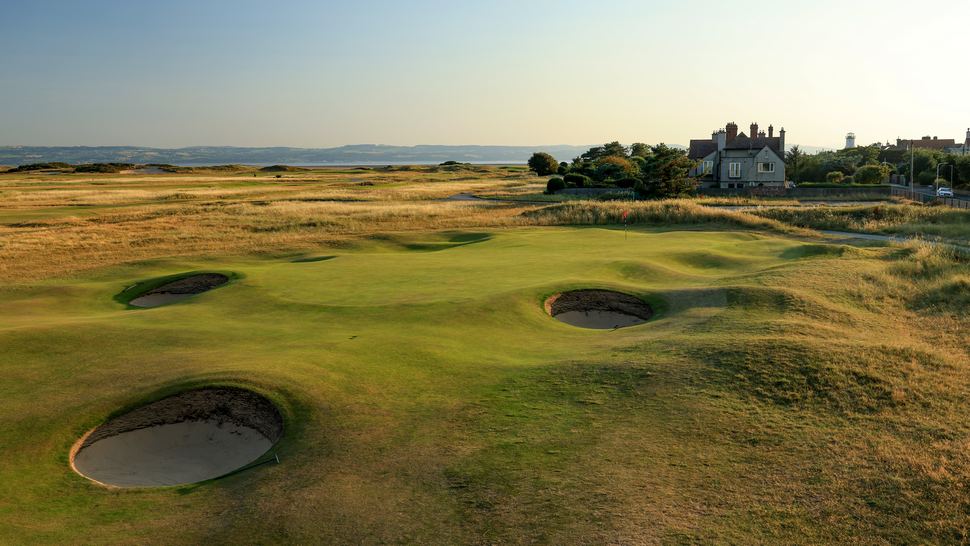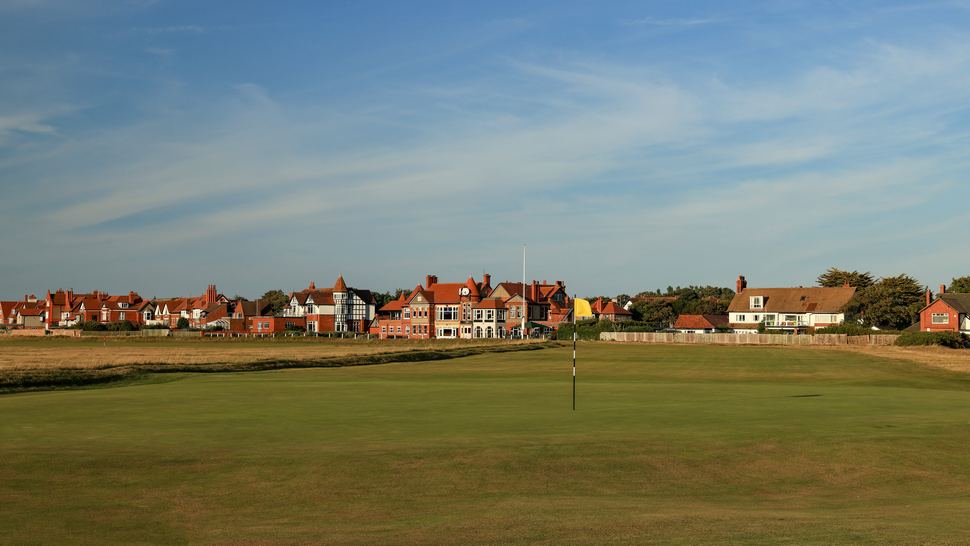The Open Championship returns for the 13th time to Royal Liverpool Golf Club and the roster of past champions includes the likes of such renowned players as Walter Hagen, Bob Jones, Peter Thomson, Roberto De Vicenzo, Tiger Woods and Rory McIlroy. Undoubtedly, an impressive roster of winners.
Located in Hoylake and approximately 13 miles from Liverpool, Royal Liverpool is a formidable links and is entirely exposed to whatever weather condition Mother Nature sees fit to present. The holes are immediately next to the Dee Estuary and as is typical with host courses for The Open the need for constant adjustments when playing is crucial for success to be attained.
The architectural firm of Mackenzie & Ebert were hired to assist in updating the course. The general routing of the 18-holes has been altered from standard play and a new short par-3 has been created and placed in the penultimate position.

The devilishly short par-3 17th presents a series of challenges. The infinity green perched above the teeing area, securing a good indication on where the pin is located, can be extremely challenging. This is especially so when a late round birdie is needed and when wind conditions are whipping about.
The course will play 7,383 yards to a par of 71. The par-5 10th changed from its usual designation to a par-4 of 507 yards. In addition, the members' 17th and 18th holes are played as the first and second. This shifts the regular 1st and 16th holes, which both bend right around corners of the driving range -- an internal out-of-bounds - as the 3rd and 18th.
This year's event will feature a majority of players who did not compete in the 2014 Open and the wherewithal to adjust to the constant varying dimensions of links golf will certainly present a clear challenge to all teeing it up.
Representatives from Mackenzie & Ebert were interviewed and provide their respective assessments on how they see matters playing out this week at the 151st Open Championship and for the fortunate golfer who takes possession of the famed Claret Jug.
***
The Participants
Martin Ebert, Director
Has worked in the golf course design business for 33 years. Advised seven of the ten Open Championship venues, including this year's venue at Royal Liverpool and including overseeing changes to the Ailsa Course at Turnberry and two new holes at Royal Portrush for The 2019 Open.
He has also recently worked with Royal County Down (NI) and on other projects in the UK, Ireland, Canada, Spain, Peru, Chile, Argentina and Japan.
Tom Mackenzie, Partner
A partner of Mackenzie & Ebert since its foundation in 2005. Formative golfing years were spent at Royal Dornoch which laid the foundation for his career.
Privileged to be a member of the team and work on many of the great courses up and down the country and further afield. Two notable projects are an ambitious masterplan for New South Wales Golf Club and exciting plans for Royal Birkdale, which will host the 2026 Open Championship
Mike Howard, Design Associate
Has been working at M&E for 7 years. Prior to that, completed an Undergraduate degree in Environmental Science at The University Of Stirling while on their golf scholarship program.
Had a year playing full time before completing a Master’s Degree in Landscape Architecture at the University Of Edinburgh prior to beginning his career in golf course architecture. His work at M&E has been wide ranging, from links-based work at Princes, Royal Cinque Ports & Hillside to inland course work as far afield as Lima in Peru and Los Leones in Chile.
***
The Open Championship returns to Royal Liverpool for the 13th time. What are the key attributes that elevate its overall stature?
Martin Ebert: Many people think of the course as flat, and it is true that there are large sections which are relatively flat, but the coastal strip enjoys some wonderful links undulations. Holes (Open numbering) 9, 10, 11, 12, 13, 14 and 17 occupy the coastal dune area of the course so a significant proportion of the layout is not without change of elevation.
However, the flatter areas do contain holes with very strong bunkering. Think of Tiger's respect for the layout in 2006, the excellent greens and the 2nd, the 3rd and 18th have internal out of bounds defined by the 'cops' - a narrow-raised bank which provides great challenge whether you like internal out of bounds or not!
The Dee Estuary also provides a wonderfully scenic backdrop to the course and the coastal edge holes in particular. The back nine is one of the finest in golf.

When someone comes to Hoylake for the first time what is the first thing they will likely notice when stepping onto the grounds?
Mike Howard: Hoylake hits you right from the moment you drive into the car park with the stunning, ivy-clad clubhouse. It is quite the sight.
Working through to the course, a first-time visitor will certainly be struck by the flatness of the ground in front of the clubhouse but, the holes amongst the dunes are visible in the distance, giving a sense of anticipation for what is to come.
Tom Mackenzie: This is where The Open layout differs from the amateurs’ experience. The opening tee shot for members and visitors across the corner of the practice ground is deeply intimidating for most players – perhaps less so for the world’s elite on the 3rd hole though.
Royal Liverpool features a reconfiguration of holes for The Open. How necessary is that in staging the event and what design features does that bring to the surface for those competing for The Claret Jug?
Mike Howard: A few glimpses at the infrastructure put in place by the R&A and it is easy to see why the member’s 16th hole being used as the 18th is a fitting finale to The Open. The run of holes at the end of the round is also sure to create an exciting finish. The memorable par 3 13th, strategic par 4 14th, reachable par 5 15th, challenging par 4 16th, nerve-wracking par 3 17th and demanding par 5 18th combine to produce a superb final stretch.
That being said, it is a shame the players do not encounter the same tense first tee shot that most golfers do when they play Hoylake. They will play the member’s 1st as their 3rd and having two ‘warm-up’ holes neuters the intimidation of that hole somewhat.
Tom Mackenzie: Most would agree that professional golf has become rather stale in recent years. The revised routing and the new 17th hole at Hoylake are all about creating golfing theatre.
It is about keeping people watching to the very end with the real possibility of major swings in scoring on both of the final holes. Someone chasing could finish 2,4 and the nervy leader could easily go 5-5. That would keep people watching and that’s what the game needs.

Players competing in the championship will encounter a new hole -- aptly named "Little Eye" at the par-3 17th which plays roughly 140 yards. What was the thinking prompting the hole's creation and position in the routing for the event?
Martin Ebert: The brief for the 136 yards long 17th -- although it is likely to be played shorter for at least one day of the championship -- was to reverse the par-3 15th hole to produce a very short but dangerous one-shot hole with a horizon line green site having the Dee estuary as a backdrop. There was an expectation that the hole should present anything from a birdie opportunity to a threat of a double bogey or worse.
I imagine that the leader of The Open, standing on the 71st tee, would not even be confident of victory, even with a three or four shot lead. A three shot, or more swing, is possible on the 17th and the same is the case on the par 5 18th with the out of bounds very much in play for the drive and second shots, especially with the extra length that the adjustment of the 17th has allowed to be gained for the closing hole.
One of the interesting aspects at Royal Liverpool is the role out-of-bounds plays on certain holes. How do you see this playing out from a strategic perspective during the championship?
Mike Hward: Early in the round, it will be interesting to see how aggressive players are on the dogleg right 3rd where the cop tightens on the right of the fairway at around 240 yards. I imagine some will play to the corner of the dogleg but I would expect a lot to play short of it and be happy to find the swale left of the green with their second, shying away from the out-of-bounds and putting trust in their short game to escape with a par.
That early in the round, I wouldn’t expect too many to be aggressive and play over the corner with the risk of running out of room, although a lot depends on the strength of the rough through the fairway here.
The 18th is the other hole where players are forced to challenge the out-of-bounds and, at this point in the round, I would expect more to play aggressively. However, I fully expect a lot to respect the cop and shy away. The left rough off the tee is sure to be a busy spot, as is the rough short and left of the green.
Elite players are smart enough to realize that using driver on a number of holes at Hoylake can be a perilous choice. How does the design tempt players to do what they generally are hesitant in doing?
Martin Ebert: Tiger took one look at the course in 2006 and decided that avoiding the bunkers was of key importance and hence adopted his strategy of not hitting the driver. However, how many other players could take on the test in that way and prevail?
He described it as his best ever ball striking week after all.
This year, I think we will see a lot more players being tempted into an aggressive strategy. It will be fascinating to see how many players take on the out of bounds at the 3rd, try to drive the 4th and 11th and whether they take on the out of bounds with a driver at the 18th.
Tom Mackenzie: Tiger’s 2006 performance was that of a virtuoso. He was by far the best of his generation, arguably of all time. Today’s elite play differently and I am sure that many will use driver, especially as the rough is unlikely to be too thick after the exceptionally dry spring.
They will throttle back on some holes in certain conditions though to avoid the ball gobbling drive bunkers.
Part Two








